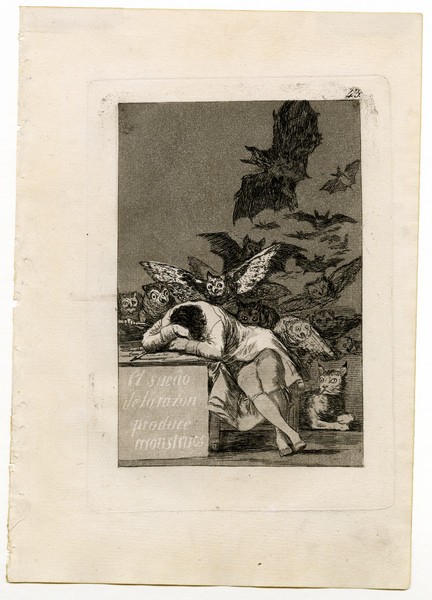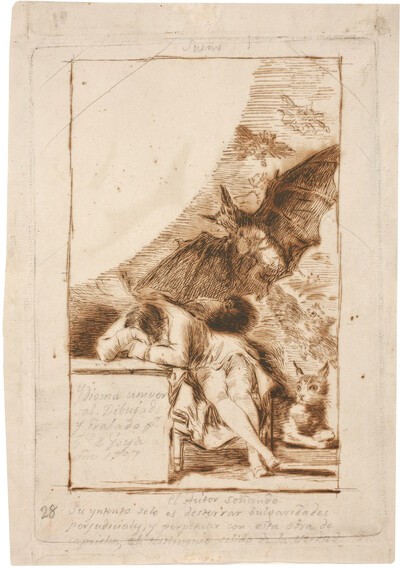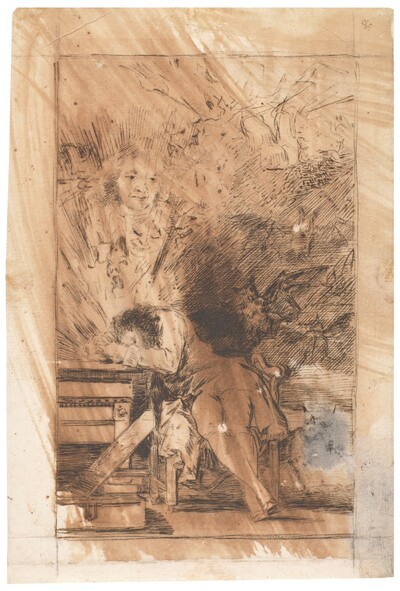- Cronología
- Ca. 1797 - 1799
- Dimensiones
- 218 x 152 mm
- Técnica y soporte
- Etching and aquatint
- Reconocimiento de la autoría de Goya
- Undisputed work
- Ficha: realización/revisión
- 15 Dec 2010 / 29 May 2024
- Inventario
- 225
el sueño de la razon produce monstruos (at the bottom)
43. (in the upper right-hand corner)
See Francisco de Goya y Lucientes, Painter.
There is a proof of the state before lettering and of the additional aquatint that is preserved in the Museum of Fine Arts, Boston.
Goya made at least two preparatory drawings for this engraving (1) and (2).
On an armchair with wheels on its legs sits a man, possibly Goya himself, who rests his arms on top of a bucket on the front of which we can read The Dream of Reason Produces Monsters. On this bucket rest various objects that allude to the man's work: pens, pencils and sheets of paper. Several nocturnal animals, bats and owls of various sizes, advance towards it from the background, which do not seem to bode well. Equally disturbing are the cat and the lynx watching the scene, as well as the two owls leaning on the bucket on which the man is sleeping.
The artist has used a two-tone aquatint, a darker one for the background and a softer one for the front of the table, where he has left a reserve of varnish with which to write the title in white letters. The light illuminates the head and shoulders of the sleeping figure, extending slightly to the owls nearest to him, as if a spotlight had been focused on his head.
This engraving is one of the most complex in the series and, at the same time, one of the richest that has been the subject of many interpretations. In order to understand it, it is necessary to refer to the manuscripts of the period, as the Ayala manuscript states: "Fantasy abandoned by reason produces monsters, and united with it is the mother of the arts". The Prado Museum's manuscript states: "The fantasy abandoned by reason produces impossible monsters: united with it, it is the mother of the arts and the origin of marvels", while the National Library's manuscript states that "when men do not hear the cry of reason, everything becomes visions". From the reading of these texts we conclude that the image has a double meaning. Firstly, Goya stresses the importance of reason, without which all kinds of irrational sentiments lead to ignorance. Reason is the light that makes us emerge from the darkness of our own subconscious and our fears.
However, it should be pointed out that the manuscripts suggest a second meaning in which the dream, as a liberation from an inner world controlled by reason, becomes an immense source of creativity. It is possible that in this print Goya had captured something of his own essence, his condition as an artist in whom the Enlightenment mentality coexisted with pre-Romantic sentiment.
The experience described in the engraving we are dealing with here would be related to what Francisco de Quevedo narrates in the prologue to The Dreams: "(...) I fell asleep: as soon as my soul was freed from the task of the external senses, the following comedy struck me in this way; and so my powers recited it in the dark, and I was an auditorium and theatre for my fantasies".
One of the possible visual sources for this engraving is the work by Salvator Rosa (Naples, 1615-Rome, 1673) entitled Democritus in Meditation (1650, Statens Museum for Kunst, Copenhagen). In it, a man in the middle of a wild landscape leans on a cube where he appears to be meditating. Both the figure in Goya's print and the Neapolitan and the portrait that the Aragonese artist painted of his friend Gaspar Melchor de Jovellanos seem to be affected by a strange form of melancholy. In line with these images is the engraving that opens Alfabeto in sogno by Giuseppe Maria Mitelli (Bologna, 1634-Bologna, 1718), in which an artist can be seen sleeping on a table.
It is also possible that the Aragonese painter was familiar with the image that opens the second volume of Jean-Jacques Rousseau's Philosophie, published in 1793. In it we can see a figure resting his head on one of his hands, seated at a table, just as the protagonist of the Goyaesque print does.
The plate is preserved in the National Chalcography (no. 214).
-
Goya. Gemälde Zeichnungen. Graphik. TapisserienKunsthalle BaselBasle1953from January 23th to April 12th 1953cat. 230
-
De grafiek van GoyaRijksmuseum RijksprentenkabinetAmsterdam1970from November 13th 1970 to January 17th 1971cat. 36
-
Goya. Das Zeitalter der Revolucionen. Kunst um 1800 (1980 – 1981)Hamburger KunsthalleHamburg1980cat. 3
-
Goya y el espíritu de la IlustraciónMuseo Nacional del PradoMadrid1988from October 6th to December 18th 1988. Exhibited also at Museum of Fine Arts, Boston, January 18th to March 26th 1989; The Metropolitan Museum of Art, Nueva York, May 9th to July 16th 1989, Madrid curator Manuela B. Mena Marqués, scientific directors Alfonso E. Pérez Sánchez and Eleanor A. Sayrecat. 52
-
Goya. La década de Los CaprichosMadrid1992organized by Real Academia de Bellas Artes de San Fernando sponsored by Fundación Central Hispano, Madrid, consultant editor Nigel Glendinnig. From October 26th 1992 to January 10th 1993cat. 7
-
GoyaNationalmuseumStockholm1994consultant editors Juan J. Luna and Görel Cavalli-Björkman. From October 7th 1994 to January 8th 1995cat. 64
-
Ydioma universal: Goya en la Biblioteca NacionalBiblioteca NacionalMadrid1996from September 19th to December 15th 1996cat. 122
-
Francisco Goya. Sein leben im spiegel der graphik. Fuendetodos 1746-1828 Bordeaux. 1746-1996Galerie KornfeldBern1996from November 21st 1996 to January 1997cat. 49
-
Das Capriccio als KunstprinzipWallraf-Richartz-Museum,1996from December 8th 1996 to February 16th 1997, exhibited also in Zurich, Kunsthaus, from March 14th marzo 1997 to June 1st 1997 and in Vienna, Kunsthistorisches Museum mi Palais Harrach, from June 29th 1997 to September 21st 1997.cat. G. 39
-
Francisco de GoyaMuseo d'Arte ModernaLugano1996exhibition celebrated from September 22nd to November 17th.cat. 43, p.70
-
Goya e la tradizione italianaFondazione Magnani RoccaMamiano di Traversetolo (Parma)2006consultant editors Fred Licht and Simona Tosini Pizzetti. From September 9th to December 3th 2006cat. 43, p.156
-
Goya. Opera graficaPinacoteca del Castello di San GiorgioLegnano2006exhibition celebrated from December 16th 2006 to April 1st 2007p.34
-
Goya e ItaliaMuseo de ZaragozaZaragoza2008organized by the Fundación Goya en Aragóna, consultant editor Joan Sureda Pons. From June 1st to September 15th 2008cat. 290
-
Goya et la modernitéPinacothèque de ParisParís2013from October 11st 2013 to March 16th 2014cat. 156
-
Goya: Order and disorderMuseum of Fine ArtsBoston2014cat. 40 / 162
-
Expérience GoyaLille2021cat. 8
-
Agen2019cat. 45
-
Madrid2017
-
London2015cat. 26
-
Madrid2019cat. 60
-
Goya engravings and lithographs, vol. I y II.OxfordBruno Cassirer1964p.115, cat. 78
-
Vie et ouvre de Francisco de GoyaParísOffice du livre1970p.181, cat. 536
-
Goya, 1746-1828. Biografía, estudio analítico y catálogo de sus pinturasBarcelonaEdiciones Polígrafa s.a.1970p.395, fig. 627
-
Goya, la década de los caprichos: dibujos y aguafuertesMadridReal Academia de Bellas Artes de San Fernando1992pp.9-13, cat. 139.141
-
Goya. El capricho y la invención. Cuadros de gabinete, bocetos y miniaturasMadridMuseo del Prado1993pp.59-61, fig. 32
-
Catálogo de las estampas de Goya en la Biblioteca NacionalMadridMinisterio de Educación y Cultura, Biblioteca Nacional1996p.96, cat. 132
-
El libro de los caprichos: dos siglos de interpretaciones (1799-1999). Catálogo de los dibujos, pruebas de estado, láminas de cobre y estampas de la primera ediciónMadridMuseo Nacional del Prado1999pp.238-245
-
Zwischen Hexensabbath und PsychoanalyseGoyas sueño de la razon und Carl du Prels dramatische Spal-tung des Ich im TraumeStaedel-Jahrbuch2001pp.213-250
-
Francisco Goya. Los CaprichosBarcelonaEdiciones de la Central2011pp.31-38
-
ParísPinacoteca de París2013p. 221
-
Goya: Order & DisorderBostonMuseum of Fine Arts Boston Publications2014pp. 101/248-249
-
LondonThe Courtauld Gallery2015pp. 134-135
-
Goya. In the Norton Simon MuseumPasadenaNorton Simon Museum2016pp. 42-75
-
ZaragozaGobierno de Aragón y Fundación Bancaria Ibercaja2017p. 220
-
AgenSnoeck2019p. 136
-
MadridMuseo Nacional del Prado2019p. 131
-
Expérience Goya (cat. expo)LilleRéunion des Musées Nationaux2021p. 32


